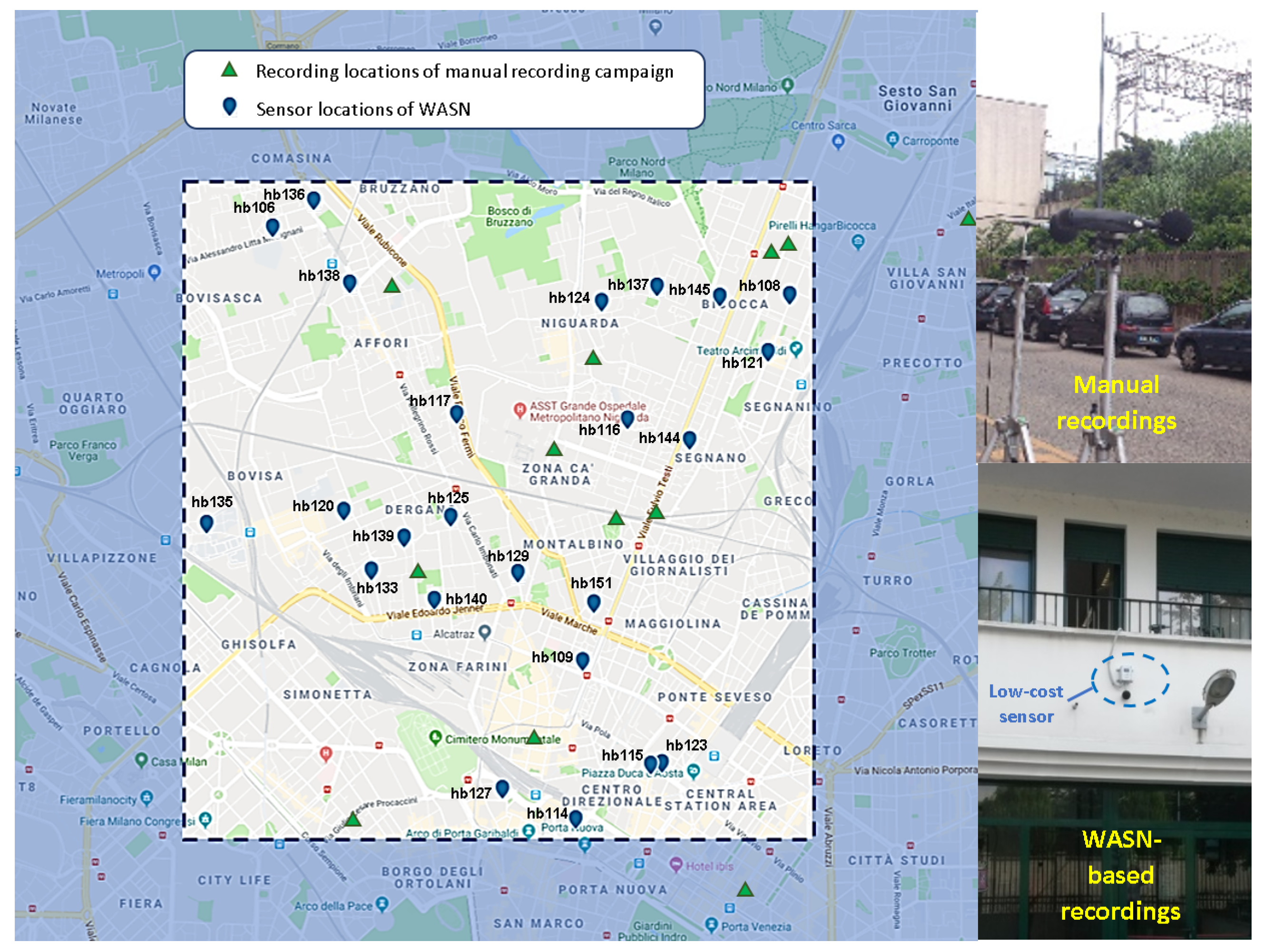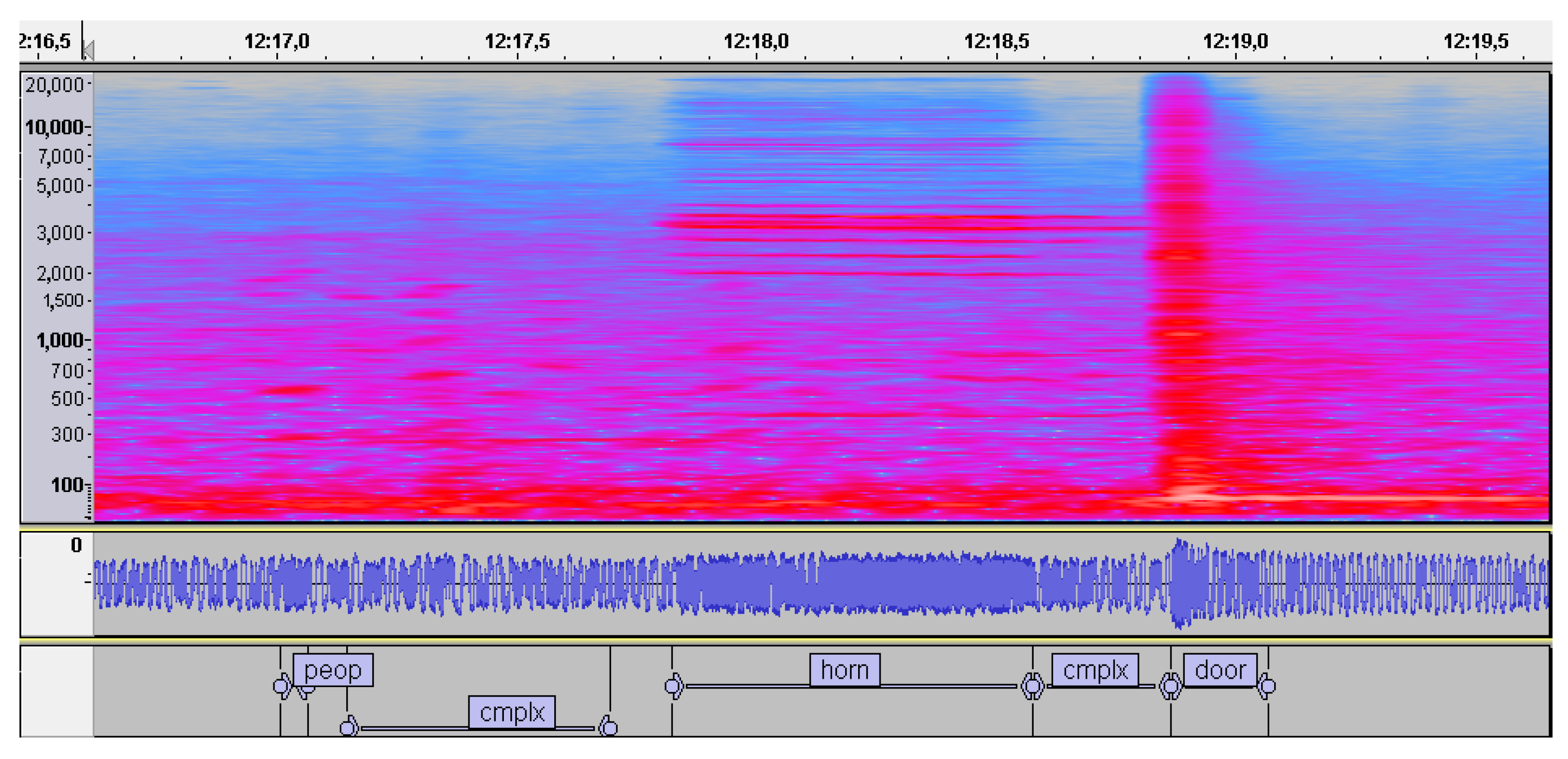Characterization of a WASN-Based Urban Acoustic Dataset for the Dynamic Mapping of Road Traffic Noise †
Abstract
:1. Introduction
2. Development of the WASN-Based Urban Acoustic Dataset
2.1. WASN Configuration and Recordings Methodology
2.2. Labeling Process and ANE Subcategories
2.3. Characteristics of the Urban ANEs Collected by the WASN Sensors
3. Discussion and Conclusions
Funding
Acknowledgments
Conflicts of Interest
References
- Botteldooren, D.; Dekoninck, L.; Gillis, D. The influence of traffic noise on appreciation of the living quality of a neighborhood. Int. J. Environ. Res. Publ. Health 2011, 8, 777–798. [Google Scholar] [CrossRef] [PubMed]
- Alberts, W.; Roebben, M. Road Traffic Noise Exposure in Europe in 2012 based on END data. In Proceedings of the 45th International Congress and Exposition on Noise Control Engineering (INTER-NOISE 2016), Institute of Noise Control Engineering, Hamburg, Germany, 21–24 August 2016; pp. 1236–1247. [Google Scholar]
- Babisch, W. Transportation noise and cardiovascular risk. Noise&Health 2008, 10, 27–33. [Google Scholar]
- Sørensen, M.; Andersen, Z.J.; Nordsborg, R.B.; Becker, T.; Tjønneland, A.; Overvad, K.; Raaschou-Nielsen, O. Long-term exposure to road traffic noise and incident diabetes: A cohort study. Environ. Health Perspect. 2013, 121, 217–222. [Google Scholar] [CrossRef] [PubMed]
- Kim, M.; Chang, S.I.; Seong, J.C.; Holt, J.B.; Park, T.H.; Ko, J.H.; Croft, J.B. Road traffic noise: Annoyance, sleep disturbance, and public health implications. Am. J. Prev. Med. 2012, 43, 353–360. [Google Scholar] [CrossRef] [PubMed]
- EU. Directive 2002/49/EC of the European Parliament and the Council of 25 June 2002 relating to the assessment and management of environmental noise. Off. J. Eur. Communities 2002, L189/12. [Google Scholar]
- Kephalopoulos, S.; Paviotti, M.; Anfosso-Lédée, F. Common Noise Assessment Methods in Europe (CNOSSOS-EU); Report EUR 25379 EN; Publications Office of the European Union: Brussels, Belgium, 2002; pp. 1–180. [Google Scholar]
- Licitra, G.; Ascari, E. Noise Mapping in the EU: State of Art and 2018 Challenges. In Proceedings of the 47th International Congress and Exposition on Noise Control Engineering (INTER-NOISE 2018), Chicago, IL, USA, 26–29 August 2018; pp. 2486–2490. [Google Scholar]
- Cerniglia, A. Development of a GIS based software for real time noise maps update. In Proceedings of the 45th International Congress and Exposition on Noise Control Engineering (INTER-NOISE 2016), Hamburg, Germany, 21–24 August 2016; pp. 6380–6386. [Google Scholar]
- Alías, F.; Alsina-Pagès, R.M. Review of Wireless Acoustic Sensor Networks for Environmental Noise Monitoring in Smart Cities. Sensors 2019, 2019, 13. [Google Scholar] [CrossRef]
- Sevillano, X.; Socoró, J.C.; Alías, F.; Bellucci, P.; Peruzzi, L.; Radaelli, S.; Coppi, P.; Nencini, L.; Cerniglia, A.; Bisceglie, A.; et al. DYNAMAP—Development of low cost sensors networks for real time noise mapping. Noise Mapp. 2016, 3, 172–189. [Google Scholar] [CrossRef]
- Zambon, G.; Benocci, R.; Bisceglie, A. Development of optimized algorithms for the classification of networks of road stretches into homogeneous clusters in urban area. In Proceedings of the 22nd International Congress on Sound and Vibration (ICSV), Florence, Italy, 12–16 July 2015; pp. 1–8. [Google Scholar]
- Bellucci, P.; Peruzzi, L.; Zambon, G. LIFE DYNAMAP project: The case study of Rome. Appl. Acoust. 2017, 117, 193–206. [Google Scholar] [CrossRef]
- Socoró, J.C.; Alías, F.; Alsina-Pagès, R.M. An Anomalous Noise Events Detector for Dynamic Road Traffic Noise Mapping in Real-Life Urban and Suburban Environments. Sensors 2017, 17, 2323. [Google Scholar] [CrossRef] [PubMed]
- Alías, F.; Alsina-Pagès, R.M.; Orga, F.; Socoró, J.C. Detection of Anomalous Noise Events for Real-Time Road-Traffic Noise Mapping: The Dynamap’s project case study. Noise Mapp. 2018, 5, 71–85. [Google Scholar] [CrossRef]
- Alsina-Pagès, R.M.; Orga, F.; Alías, F.; Socoró, J.C. A WASN-Based Suburban Dataset for Anomalous Noise Event Detection on Dynamic Road-Traffic Noise Mapping. Sensors 2019, 19, 2480. [Google Scholar] [CrossRef] [PubMed]
- Alías, F.; Socoró, J.C. Description of anomalous noise events for reliable dynamic traffic noise mapping in real-life urban and suburban soundscapes. Appl. Sci. 2017, 7, 146. [Google Scholar] [CrossRef]
- Orga, F.; Alías, F.; Alsina-Pagès, R.M. On the Impact of Anomalous Noise Events on Road Traffic Noise Mapping in Urban and Suburban Environments. Intl. J. Environ. Res. Publ. Health 2017, 15, 13. [Google Scholar] [CrossRef] [PubMed]


| Label | Description | Label | Description |
|---|---|---|---|
| airp | Noise of airplanes and helicopters | musi | Music in car or in the street |
| alrm | Sound of an alarm or a vehicle beep moving backwards | peop | Sounds of people chatting, laughing, coughing, sneezing, etc. |
| bell | Church bells | rain | Sound of heavy rain |
| bike | Sound of bikes and bike chains | rubb | Rubbish service, sound of engine taking the container, emptying it and dropping it down |
| bird | Birdsong | sire | Sirens (ambulances, police, etc.) |
| blin | Opening and closing of a blind | sqck | Squick sound of door hinges |
| brak | Brakes and conveyor belts | step | Sounds of steps |
| busd | Opening bus door (or tramway), depressurized air | thun | Thunderstorm |
| dog | Barking of dogs | tram | Stop, start and pass by sounds of tramways |
| door | Closing doors (vehicle or house) | tran | Sound of trains |
| glas | Sound of glass crashing | trll | Sound of wheels of suitcases (trolley) |
| horn | Horns of vehicles (cars, motorbikes, trucks, etc.) | wind | Noise of wind (movement of the leaves of trees, ...) |
| inte | Interfering signal from an industry or human machine | wrks | Works in the street (e.g. saws, hammer drills, etc.) |
Publisher’s Note: MDPI stays neutral with regard to jurisdictional claims in published maps and institutional affiliations. |
© 2019 by the authors. Licensee MDPI, Basel, Switzerland. This article is an open access article distributed under the terms and conditions of the Creative Commons Attribution (CC BY) license (https://creativecommons.org/licenses/by/4.0/).
Share and Cite
Alías, F.; Socoró, J.C.; Orga, F.; Alsina-Pagès, R.M. Characterization of a WASN-Based Urban Acoustic Dataset for the Dynamic Mapping of Road Traffic Noise. Proceedings 2020, 42, 60. https://doi.org/10.3390/ecsa-6-06637
Alías F, Socoró JC, Orga F, Alsina-Pagès RM. Characterization of a WASN-Based Urban Acoustic Dataset for the Dynamic Mapping of Road Traffic Noise. Proceedings. 2020; 42(1):60. https://doi.org/10.3390/ecsa-6-06637
Chicago/Turabian StyleAlías, Francesc, Joan Claudi Socoró, Ferran Orga, and Rosa Ma Alsina-Pagès. 2020. "Characterization of a WASN-Based Urban Acoustic Dataset for the Dynamic Mapping of Road Traffic Noise" Proceedings 42, no. 1: 60. https://doi.org/10.3390/ecsa-6-06637
APA StyleAlías, F., Socoró, J. C., Orga, F., & Alsina-Pagès, R. M. (2020). Characterization of a WASN-Based Urban Acoustic Dataset for the Dynamic Mapping of Road Traffic Noise. Proceedings, 42(1), 60. https://doi.org/10.3390/ecsa-6-06637








